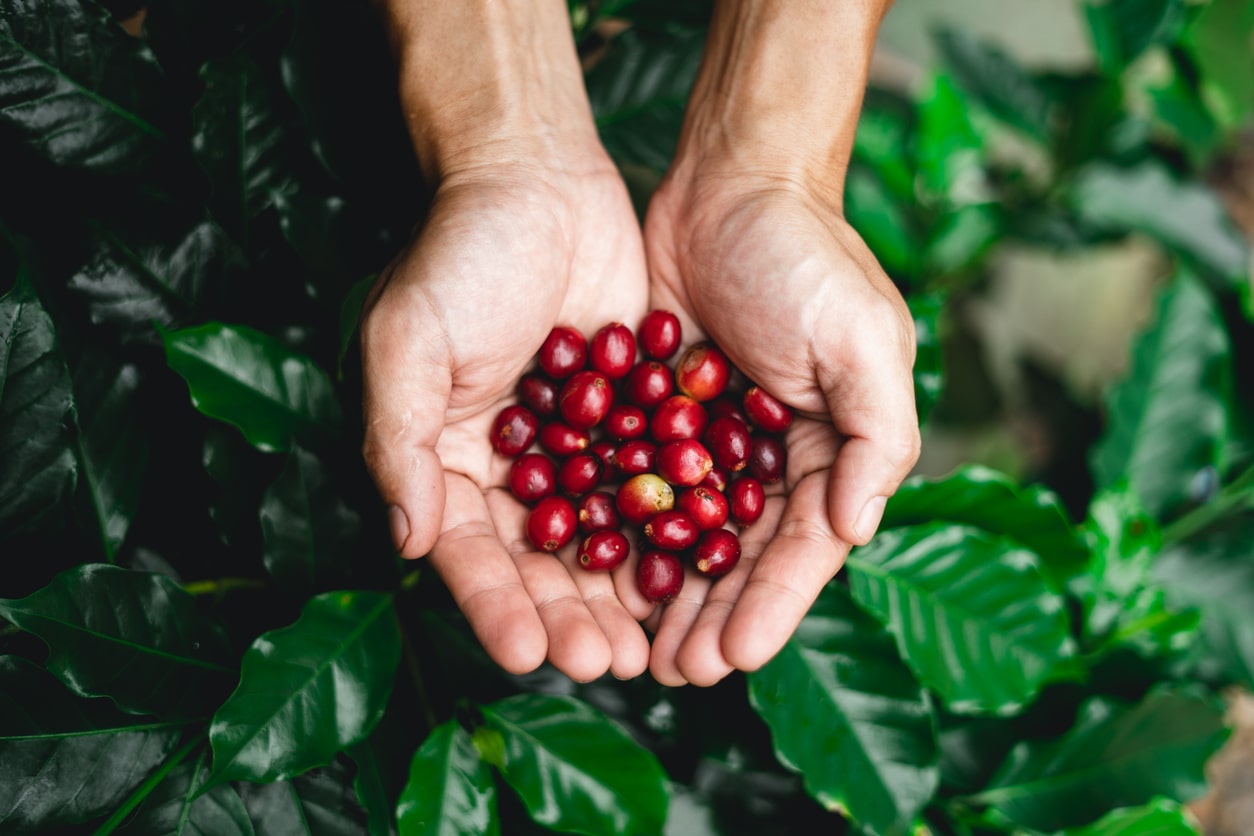
The coffee plant: from cultivation to harvest
In Italy the ritual of coffee has become truly iconic over the centuries: an essential boost for a good start to the day, a relaxing break from everyday tasks, a convivial moment with friends, an excuse to sit and chat. Every country in the world has its own traditions and methods of preparation, but for Italians, espresso is almost an obligation.
The coffee plant
As you sip a good coffee, how often do you stop and think about how this fascinating beverage is grown and obtained? It all starts with the coffee plant, a shrub with rather distinctive leaves, which provides us with this unique product.
The spread of coffee cultivation is due to an increasingly wide botanical knowledge of the plant, which has favoured certain varieties and developed the specific characteristics of their beans. Over time we have seen huge expansion and liberalisation in the coffee market, which today covers several areas of the world.
Where does the coffee plant come from?
The coffee plant - Coffea - is originally from Ethiopia, and is now widespread in all tropical countries. There are currently some 60 known species of the plant, including Arabica, undoubtedly the best-known among the general public, whose fruits are considered superior.
The trunk of the Coffea plant has two types of branches, primary and secondary. The leaves are bright green and the flowers are white, fairly showy and placed near the leaves. The plant does not flower just once, but several times a year; the flowers then become the coffee fruits, which in a few months ripen to juicy and shiny red berries, encasing the valued beans we all know.
Coffee cultivation
It all starts with the selection of the best beans. This is an essential stage, as the quality of the end product and the blend depends on the beans selected.
How coffee is grown
During the first year after sowing, the plants are kept in greenhouses or nurseries under controlled conditions. They are then transplanted to their definitive sites, where they are fertilised and pruned as necessary.
Then comes a series of procedures for the care of the plant, according to general botanical principles. The growing phases related to flowering and fruiting are nowadays overseen by specialist firms who employ increasingly advanced and efficient techniques.
When is coffee harvested?
The coffee harvest takes place at the end of the fruit ripening cycle, in a carefully controlled atmosphere. There is no fixed season, as the cycle depends heavily on the geographical area of cultivation.
Influences on the harvest are not limited to the region, also include the climate, the seasons and the altitude of the plantation. In Central America, the harvest is between October and March, while in Africa the ideal time is late October to early April, and in Brazil the harvest is between May and September. Depending on the rains, there may be greater or lesser quantities of fruit on the plants, and this has a large bearing on the harvest method.
How is coffee harvested?
One of the most common ways of harvesting coffee is by hand: the drupes are picked one by one or by combing the branches with the hands, in techniques passed down through generations. These techniques are called picking and stripping respectively.
Picking undoubtedly guarantees a superior product, as it requires more selection and attention, but this method has a considerable impact on time and cost. Stripping is a faster process, but obviously can be less accurate, with drupes picked at various stages of ripeness, thus affecting the flavour of the end product.
Conclusions
Nowadays we can buy coffee practically anywhere; it´s found in the smallest corner shop and the largest supermarket. If you want to try a unique coffee, what you need is Caffè Corsini, representing Tuscan excellence in the world with craftsmanship and tradition.
But to create our coffees, we go back to their origins. Our work researching and selecting the berries and then the beans is done right on the coffee plantations. We then process the raw materials with great care, from roasting to packaging.
On our e-commerce site you can buy the best blends online, choosing your favourite format: ground, beans, capsules, pods and much more.
The coffee plant
As you sip a good coffee, how often do you stop and think about how this fascinating beverage is grown and obtained? It all starts with the coffee plant, a shrub with rather distinctive leaves, which provides us with this unique product.
The spread of coffee cultivation is due to an increasingly wide botanical knowledge of the plant, which has favoured certain varieties and developed the specific characteristics of their beans. Over time we have seen huge expansion and liberalisation in the coffee market, which today covers several areas of the world.
Where does the coffee plant come from?
The coffee plant - Coffea - is originally from Ethiopia, and is now widespread in all tropical countries. There are currently some 60 known species of the plant, including Arabica, undoubtedly the best-known among the general public, whose fruits are considered superior.
The trunk of the Coffea plant has two types of branches, primary and secondary. The leaves are bright green and the flowers are white, fairly showy and placed near the leaves. The plant does not flower just once, but several times a year; the flowers then become the coffee fruits, which in a few months ripen to juicy and shiny red berries, encasing the valued beans we all know.
Coffee cultivation
It all starts with the selection of the best beans. This is an essential stage, as the quality of the end product and the blend depends on the beans selected.
How coffee is grown
During the first year after sowing, the plants are kept in greenhouses or nurseries under controlled conditions. They are then transplanted to their definitive sites, where they are fertilised and pruned as necessary.
Then comes a series of procedures for the care of the plant, according to general botanical principles. The growing phases related to flowering and fruiting are nowadays overseen by specialist firms who employ increasingly advanced and efficient techniques.
When is coffee harvested?
The coffee harvest takes place at the end of the fruit ripening cycle, in a carefully controlled atmosphere. There is no fixed season, as the cycle depends heavily on the geographical area of cultivation.
Influences on the harvest are not limited to the region, also include the climate, the seasons and the altitude of the plantation. In Central America, the harvest is between October and March, while in Africa the ideal time is late October to early April, and in Brazil the harvest is between May and September. Depending on the rains, there may be greater or lesser quantities of fruit on the plants, and this has a large bearing on the harvest method.
How is coffee harvested?
One of the most common ways of harvesting coffee is by hand: the drupes are picked one by one or by combing the branches with the hands, in techniques passed down through generations. These techniques are called picking and stripping respectively.
Picking undoubtedly guarantees a superior product, as it requires more selection and attention, but this method has a considerable impact on time and cost. Stripping is a faster process, but obviously can be less accurate, with drupes picked at various stages of ripeness, thus affecting the flavour of the end product.
Conclusions
Nowadays we can buy coffee practically anywhere; it´s found in the smallest corner shop and the largest supermarket. If you want to try a unique coffee, what you need is Caffè Corsini, representing Tuscan excellence in the world with craftsmanship and tradition.
But to create our coffees, we go back to their origins. Our work researching and selecting the berries and then the beans is done right on the coffee plantations. We then process the raw materials with great care, from roasting to packaging.
On our e-commerce site you can buy the best blends online, choosing your favourite format: ground, beans, capsules, pods and much more.
Blog posts

NEWS
Conciliazione Vita-Lavoro: Bando welfare aziendale Regione Toscana
Conciliazione Vita-Lavoro: Bando welf...
Read more
The best coffee recipes with the Thermomix®: breakfast, break and after dinner
Long, short, espresso. Macchiato, cre...
Read more
